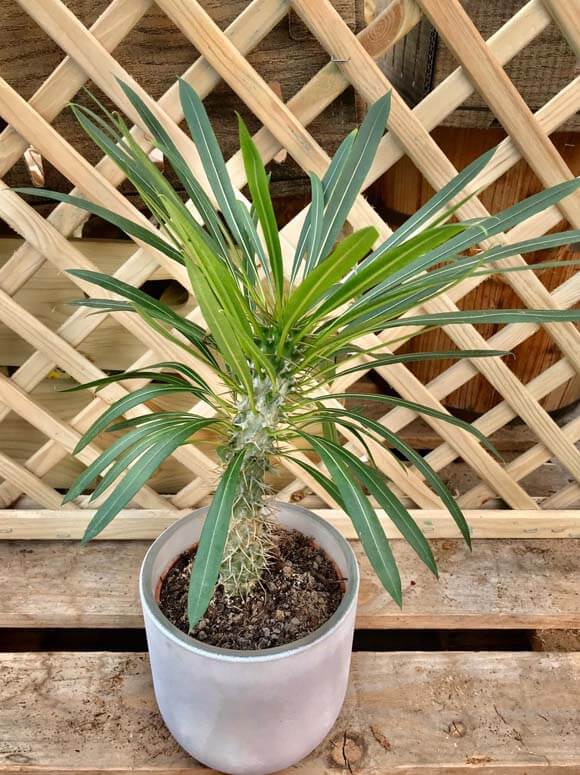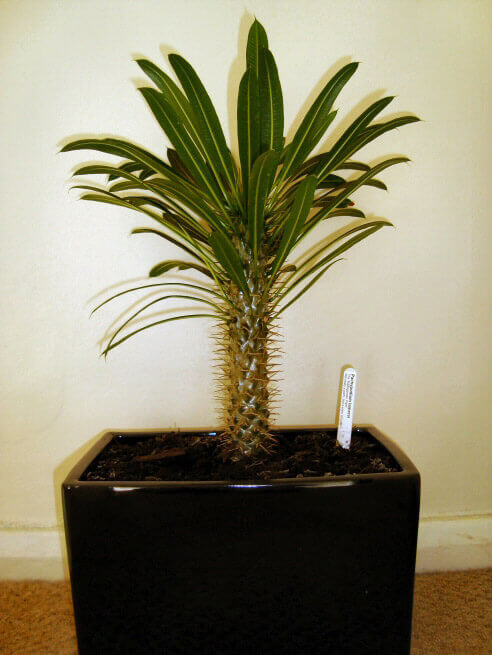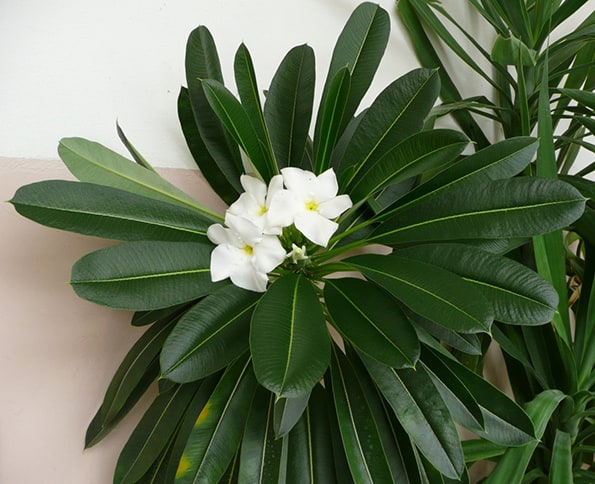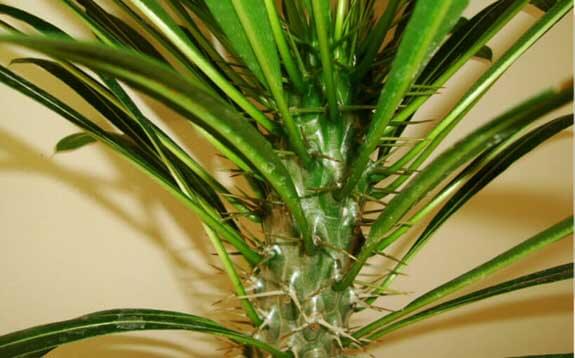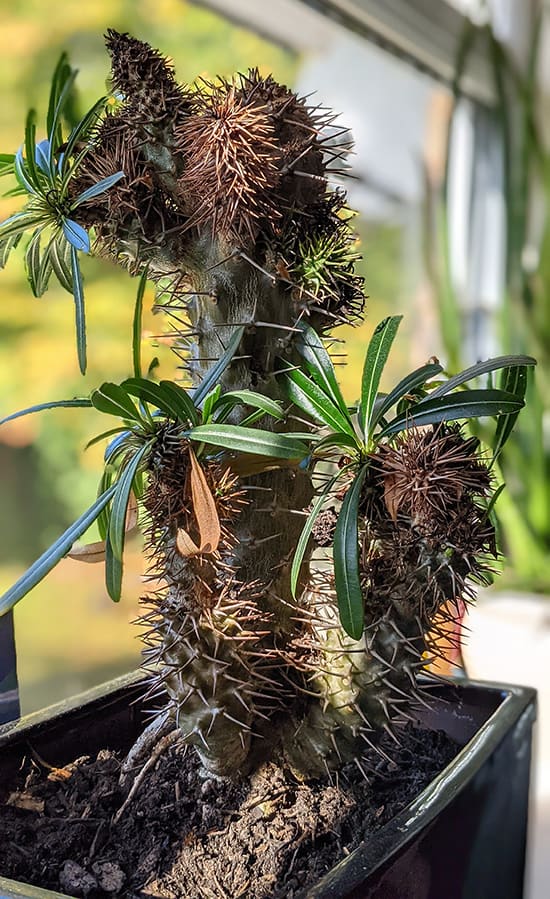Despite its common name of Madagascar Palm (or a Pachy to its fans), the Pachypodium is actually a succulent and, therefore, more closely related to cacti than palms.
This striking houseplant hails from Madagascar and because it has leaves growing around the crown this combination gives rise to the common name of Madagascar Palm.
Madagascar Palms can grow very tall, but even eventual giants need to start somewhere.
Another houseplant that Dr Hessayon describes as "unusual rather than attractive" and on this occasion because it looks a bit like a dieting pineapple (yes, you did read that right), we're going to agree.
It may not be the most popular plant to stumble across in the average nursery or garden shop, but for anyone who likes a quirky, easy going indoor succulent, this could be your perfect match.
How do you pronounce Pachypodium correctly? Say:
pack-ee-POE-dee-um
Pachypodium means "thick foot" and refers to the thick swollen stem that stores water and gives the plant structure and strength.
The swollen stem grows upwards with the leaves surrounding the crown gradually falling and then growing new ones as it ages.
All parts of Pachypodium contain a latex sap which is poisonous. Although even if you do have pets this may not be a total deal breaker because the plant protects itself by way of tough hooked spines that will deter even the most curious cat.
The leaves are fair game for possible gnawing though. So unless they're sitting high up on a tall plant and therefore out of the way, you'll have to think carefully before purchasing.
Unusual looking succulent plants can sometimes really suit unusual growing containers.
There are several species, although the easiest and the most likely ones you will come across are either Pachypodium lamerei or Pachypodium geayi.
Although they've got the same care requirements, they're quite hard to tell apart. In general, Pachypodium geayi has more of a metallic grey trunk, whereas the lamerei species is light grey with more green mixed in.
They're sometimes confused with the Adenium (Desert Rose) and although they're both succulent plants, the Pachypodium rarely flowers in cultivation and has spines. When compared side by side, they're quite distinctive and different looking.

Hi, I'm Tom!
If you're like me and enjoy the challenge of growing houseplants and getting them to thrive, then Ourhouseplants can help. This website shares my knowledge and years of growing plants and provides (hopefully) helpful advice on properly caring for your indoor plant friends.
This is a sun-loving houseplant so always pick the sunniest spot you have. They'll still do pretty well in bright conditions, but anything considered "medium" light or lower should be avoided.
These plants put out almost all of their new growth during the Summer. So, in theory, you could bring your plant indoors to a slightly lower lit location over late fall, winter and early spring before moving it outside to a sunny spot.
A common myth about succulents is that they don't need much water. It's true they will survive much longer than some other houseplants with higher watering needs, but even the most resilient succulents won't thrive if you treat them this way.
A common myth about succulents is that they do not need much water
If you want a thriving Pachypodium, water yours liberally in the Summer months whenever the soil dries out. In Winter you should cut back to prevent the roots from rotting in the cooler conditions, instead only water sparingly. Perhaps once or twice a month at most.
Unimportant.
The Pachypodium is not a heavy feeder, so you will only need to fertilize a few times a year at most. As always only do it when the plant is in active growth. You can spring a few slow release feed granules around the soil surface, or use liquid fertilizer.
They're adapted to surviving in warm climates and therefore warm temperatures are needed for this plant. No lower than 10°C (50°F) in Winter.
In the growing seasons you should ideally try and grow it in direct sunlight which should mean they're being warmed by the sun. This is another reason to try and avoid darker spots in your home, which will be cooler and put the plant at a disadvantage.
They take considerable time to outgrow their pots, however you may choose to repot your Pachypodium if it starts to wobble or topple from becoming top-heavy.
They can look pretty good in strange funky containers too. Just be careful as if the planter you pick doesn't have any drainage holes, overwatering and root rot are more likely.
A standard soil mix is fine, but if you want to be extra safe, add a little bit of grit to improve drainage or use a labeled succulent / cacti compost mix. You can repot your plant at any time of the year, however take care when you do it because the spines can be painful if you grab the stem in the wrong way.
These plants can get real big (see the photos in the comment section below), so repotting might not be possible. In those circumstances, top dress by removing the top inch of soil and replacing it with fresh.
Courageous readers may like to try and remove then pot up the offsets that are eventually produced around the base. Although, it's difficult for the average houseplant owner to do this successfully.
This is a slow growing plant. However, if you water well and provide good light levels in Summer you'll notice more growth at this time of the year. Growth at any other time of the year is less common.
Natively it can reach staggering heights, although In cultivation it's much more restrained. After many (and we do mean many) years the stem could reach upwards of 4ft / 1.2m in height and up to 24in / 60cm in diameter.
Out in their native habitat, the trunk can branch out so you end up with multiple stems, but this is much less likely to happen indoors.
The flowering of the Madagascar Palm is rare indoors because the plant needs to reach maturity and tall heights first. There are always exceptions of course and if you do achieve flowers they will be white, numerous and star-shaped.
The Madagascar palm plant does not flower very often when grown indoors, but when it does you will get to see the creamy white flowers. Photo by Bach01.
The white and yellow flowers can be fragrant, depending on the species and they tend to last a few weeks.
The sap is poisonous to pets and people. However, it's difficult to get at due to the protective spines on the trunk, so your pet or child will likely avoid the plant as a result. In fact, more damage is caused by these spines than the plant's sap.
Although the sap within the plant is an irritant, most pets and children will be deterred by the protective spines.
Pachypodiums are adaptive houseplants and will take a wide range of temperature and light changes and adjust accordingly.
Our instructions above will help you grow a good specimen, but even if you treat it badly from time to time it should stay alive for quite a long time.
High Light These are high light loving houseplants that want full sun. Either place it in a south facing window or if this can't be provided move it outside during the Summer.
Moderate Watering Warm temperatures and lots of light will mean more water is needed than if you choose a cooler less bright location.
Temperature Pachypodium plants do not like the cold. Always avoid anything close to sub zero temperatures. Warmer the better.
Feeding You don't need to feed these plants frequently, but once or twice over the Summer would be helpful.
Roots of Pachypodium are rotten and black (Root Rot)
This is a classic result of overwatering and constantly saturated soil, especially in Winter. If the rot isn't too widespread remove the dead roots, follow our watering instructions here going forward and the plant should eventually recover.
If all the roots are dead then the plant like many a cactus is likely a lost cause, as a last ditch effort you can still remove all the dead roots and pot the "trunk" into fresh moist (not wet) compost then put in a light and warm place. There is a possibility new roots will grow from the base.
Leaves falling off (Summer)
The leaves only grow around the top of the plant, as it ages it's normal therefore to see the lower leaves falling off a Pachypodium. In a short while new leaves will emerge from the crown to replace those which have fallen.
This might look like a problem, but it could also be natural. It depends on where and how you're growing the plant and the time of the year.
Leaves falling off (Winter)
If the plant has been positioned in a hot spot with great Winter sunlight it may have been fooled into thinking it's still Summer, in which case it will still be growing (see issue above), i.e. this leaf fall is normal and nothing to be concerned about.
However if the plant is "resting" and growth has completely stopped, but leaves are still falling it could be a sign the temperature is too low and dormancy has been triggered. Completely withhold watering until new leaves start to appear in the middle of Spring onwards (this could take up to a month or two).
If all leaves fall off, it's time to inspect the roots for root rot. If there is no sign of rot, wait until Spring comes around and new leaves should start growing again.
Credit for Pachypodium flower photo - Article / Gallery - Bach01
